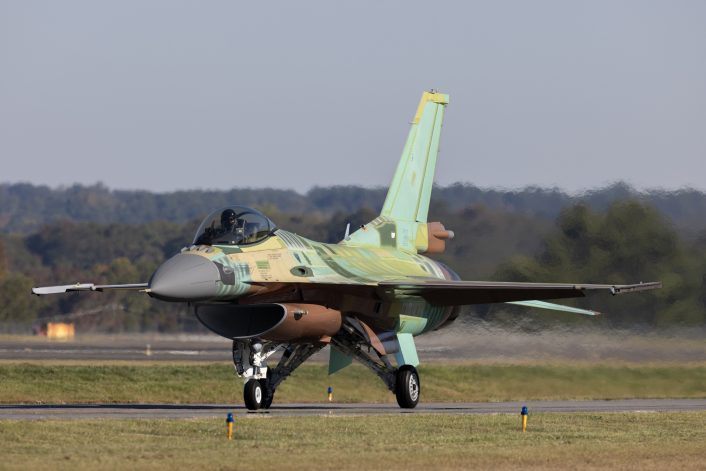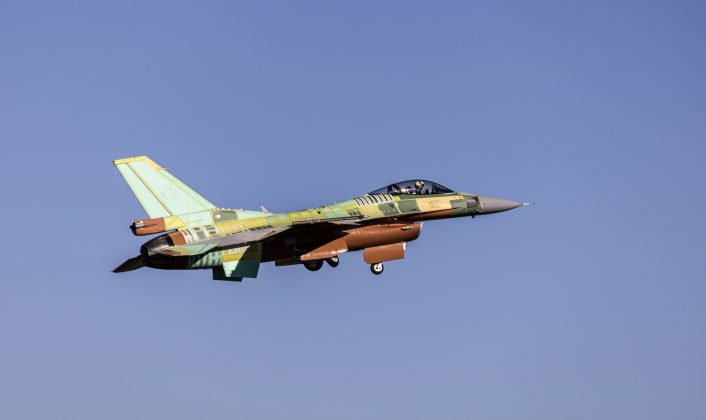Lockheed Martin announced that the first Bulgarian F-16C Block 70 has successfully flown for the first time on Oct. 22, 2024, at the company’s production facility in Greenville, South Carolina. As part of the maiden flight, test pilot Charles “Seeker” Hoag successfully conducted multiple system tests to validate performance and supersonic capabilities during the flight, said a statement.
Bulgaria will be the second European country (the first being Slovakia) to receive the F-16 Block 70, with a total of 16 fighters to be delivered. Bulgaria acquired the aircraft in two batches, signing a first Letter of Acceptance (LOA) for eight F-16s in 2019 and a second LOA for an additional eight jets in 2022.
“The F-16 has proven its 21st Century Security capabilities time and again,” said OJ Sanchez, vice president and general manager, Integrated Fighter Group at Lockheed Martin. “With the F-16 Block 70, the Bulgarian Air Force will be well-equipped to secure its borders and partner with U.S, European and NATO allies.”
The production of the first eight Bulgarian aircraft started at the beginning of the year and the first aircraft, MY-01, is scheduled to be delivered to Bulgaria in 2025, while the second batch will be delivered from 2027. Pilot and maintainer training is already ongoing in the United States.
 The first Bulgarian F-16C Block 70. (Image credit: Lockheed Martin)
The first Bulgarian F-16C Block 70. (Image credit: Lockheed Martin)
Bulgarian Vipers
After the 2019 LOA, Lockheed Martin has been awarded a 512M USD contract for the production of the first eight F-16 Block 70 jets for Bulgaria in 2020. In 2022, the second batch of aircraft was approved by the government, with an acquisition cost close to $1.3 billion. The second contract included additional spare parts and weapons.
The 16 aircraft will equip the Bulgarian Air Force (BuAF) with a full squadron, replacing a squadron of 8 MiG-29s. the Soviet-era fighters are being repaired so they can continue to fly for the foreseeable future. The Fulcrums will be gradually retired only after the delivery of the F-16s.
Bulgaria decided to acquire the Viper (as the F-16 Fighting Falcon is dubbed in the fighter pilots’ community) in July 2019. The deal concerned six single-seater jets and two twin-seaters as part of the first batch, but it’s jets unknown how many twin-eaters are part of the second batch.
As part of the deal, Bulgaria also received two Excess Defense Article (EDA) F-16A Block 15 aircrafts for use as training aides in support of the acquisition of new F-16 Block 70. The decommissioned F-16s are meant to be used as training aides in support of the National Aviation Training Center in the Bulgarian Air Force Academy and will not be regenerated into flying status.
 The first Bulgarian F-16C Block 70 leaving Greenville during its maiden flight. (Image credit: Lockheed Martin)
The first Bulgarian F-16C Block 70 leaving Greenville during its maiden flight. (Image credit: Lockheed Martin)
The F-16 Block 70
The F-16 Block 70/72 are the most advanced production Vipers, which are newly built as opposed to the F-16V which are existing aircraft upgraded to the same configuration. So far, six countries have selected the F-16 Block 70/72 and Lockheed Martin has a production backlog of more than 100 jets.
Among the new systems installed during the upgrade we can find the APG-83 AESA (Active Electronically Scanned Array) radar, a new Center Pedestal Display (CPD), the AN/APX-126 Advanced IFF (Identification Friend or Foe), Link 16 datalink, full NVIS (Night Vision Imaging System) and JHCMS II (Joint Helmet-Mounted Cueing System II) compatibility, a new Embedded GPS/INS (EGI), a modern commercial off-the-shelf (COTS)-based avionics subsystem, a high-volume, high-speed data bus and the Automatic Ground Collision Avoidance System (Auto GCAS).
“The F-16 Block 70 is the latest edition of one of the most combat proven fighter jets of all time,” said Col. Thomas Obrochta, 162nd Operations Group commander, when the first Slovak F-16 Block 70 arrived at the Arizona ANG’s 162nd Wing. “It includes an advanced APG-83 Active Electronically Scanned Array [AESA] fire control radar, a high-resolution Center Pedestal Display, which provides critical tactical imagery to pilots and allows them to take full advantage of AESA and targeting pod data, advanced weapons integration, and an extended structural life of 12,000 hours– more than 50 percent beyond that of previous production F-16 aircraft.”
The APG-83 Scalable Agile Beam Radar (SABR), developed by Northrop Grumman, is an AESA (Active Electronically Scanned Array) radar designed to fit the F-16 with no structural, power or cooling modifications; in addition, it enables the F-16 to detect, track and identify a greater number of targets (reportedly more than 20 at the same time) faster and at longer ranges while providing all-weather, high-resolution Synthetic Aperture Radar (SAR) mapping. The system also integrated a robust electronic protection to operate in hostile electronic environments.
The Block 70 features a new cockpit concept, with the installation of a Center Pedestal Display (CPD), that provides the pilot with critical tactical data on a high resolution 6’’x8’’ screen. The new screen allows pilots to take full advantage of the new radar and targeting pod data, including new color moving map, a larger and easier representation of the air-to-air situational displays with zoom functionality and last but not least the ability to switch information among displays.
